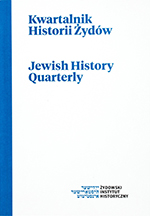Hebrajski jako język mówiony. Prozodyczna podstawa opisu języka hebrajskiego w Kitāb al-Chazarī (Sefer ha-Kuzari) Jehudy Ha-Lewiego. Kitāb al-Chazarī II: 72-80 – próba tłumaczenia i interpretacji
Hebrew as a spoken language. Prosodic Basis of the Description of the Hebrew Language in Yehudah ha-Levi’s Kitāb al-Chazarī (Sefer ha-Kuzari). Kitāb al-Chazarī II: 72-80 – a Translation and Interpretation Attempt
Author(s): Maciej TomalSubject(s): Language studies, History of Judaism
Published by: Żydowski Instytut Historyczny
Keywords: Yehudah ha-Levi; Hebrew language; phonetics; phonology; prosody
Summary/Abstract: Towards the end of the second chapter of Kitāb al-Chazarī, Yehudah ha-Levi appended a section devoted to the Hebrew language (no. 72–80), or more precisely to the mode of the biblical text’s recitation. In response to the Khazars’ king question, the Jewish sage (haver) explains what enables all Jewish readers of the Hebrew Bible to recite its text in the exactly same manner in terms of vowels’ length, accentuation and intonation (including pauses). The relevant section opens with the general characteristic of the Hebrew vowels, which seems to be based on the scheme of the so called “cardinal vowels.” The most intriguing part of the description refers to the three “degrees” of phonetic realization of a Hebrew word. The “linguistic” section of Kitāb al-Chazarī has already been subjected to scholarly studies, most recently by Ilan Eldar (2016). Yet, it appears that some aspects of Halevi’s description still call for a more detailed analysis. In this paper, I offer a coherent reading of this section. The basic concept underpinning Halevi’s discussions refers to the idea of “weak letters” presented by Jehudah Ibn Hayyuj in his Kitab al-Afʿal Zawat Huruf al-Lin. In Kitāb al-Chazarī, however, this theory is elaborated in a more sophisticated fashion, which enables its author to reconstruct the “original” or “primordial” phonetic realisation of a Hebrew word. This realisation is not necessarily equal to the one testified by dictionaries. With this assumption in mind, I attempt to trace basic phonological rules of the Biblical Hebrew according to Yehuda ha-Levi.
Journal: Kwartalnik Historii Żydów
- Issue Year: 266/2018
- Issue No: 02
- Page Range: 291-322
- Page Count: 32
- Language: Polish

